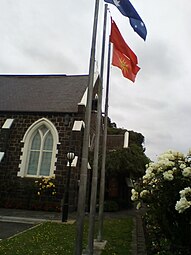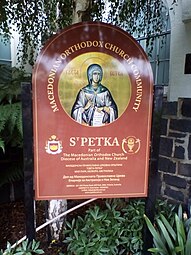St. Petka Macedonian Orthodox Church, Mill Park
 From Wikipedia - Reading time: 8 min
From Wikipedia - Reading time: 8 min
| St. Petka Macedonian Orthodox Church | |
|---|---|
Македонска Православна Црква „Св. Петка“ Makedonska Pravoslavna Crkva „Sv. Petka“ | |
 | |
Location in greater metropolitan Melbourne | |
| 37°40′29″S 145°04′12″E / 37.674586°S 145.070058°E | |
| Location | 281-285 Plenty Road, Mill Park 3082, Melbourne, Victoria |
| Country | Australia |
| Denomination | Macedonian Orthodox |
| Previous denomination | Presbyterian |
| Website | St. Petka Church |
| History | |
| Former name(s) | Janefield Presbyterian Church |
| Status | Church |
| Dedication | St. Paraskeva |
| Consecrated | 2000 |
| Architecture | |
| Functional status | Active |
| Architectural type | Church |
| Completed | 1861 |
| Administration | |
| Diocese | Macedonian Orthodox Diocese of Australia and New Zealand |
| Clergy | |
| Priest(s) | Reverend Father Tone Gulev |
St. Petka Macedonian Orthodox Church (Macedonian: Македонска Православна Црква „Св. Петка", Makedonska Pravoslavna Crkva "Sv. Petka“) is the Macedonian Orthodox church located in Mill Park, a suburb of northern Melbourne, Victoria, Australia.[1][2] The church is an old bluestone building with a new Orthodox interior, alongside nearby community facilities.[3][4] Built in 1861 as a Presbyterian church, the building is one of a few early churches built in the Plenty Valley area[3] and is listed on the Victorian Heritage Register.[5] In the late 1990s, the church was transformed into a Macedonian Orthodox Church and joined the local Macedonian Orthodox Diocese.[3][4]
History and structure
[edit]The church was constructed in 1861 and belonged to the Christian Presbyterian denomination.[3] Known as the Janefield Presbyterian Church and located in the Plenty Valley, an area of Scottish settlement, the church was one of three built in the region at the time.[3] The church itself is small, built from blue stone, and its roof is hipped and laid with slate tiles, alongside additional structures on the building's east and west sides.[6] By the late twentieth century, the building had fallen into disrepair and a 1990 Whittlesea Heritage study described its "poor structural condition" was caused by movements from unstable footings and wall cracks, due to its large windows.[3] The study noted the continuation of problems emanated from the building's inadequate design and lacked quality skilled masonry.[3] The church nonetheless was listed on the local heritage overlay and proposed for the Victorian Heritage and the Australian Heritage Commission Register.[3]
The building was in a dilapidated state when it was bought in 1996 by the Australian-New Zealand Macedonian Orthodox Diocese.[3] The church became part of the Macedonian Diocese during 1997 and its consecration occurred in 2000.[4] Extensive repairs were made to the structure and the whole church interior was rebuilt and remade into a Byzantine-Orthodox design.[3] An iconographer from Romania painted high quality frescoes on each of the church's interior walls.[3] The Orthodox iconography creates the appearance of a larger space then otherwise is in the small interior, inducing mystical overtones.[3] During the liturgy, an atmospheric interior is generated through ceremonial practices such as the use of candles, incense, ritual foods and performance of choir singing.[3] Nearby, a few additional buildings have been constructed to serve the needs and activities of the congregation.[4] The local Macedonian community celebrated the twentieth anniversary of the church in November 2017.[4]
Gallery
[edit]-
Side view of church
-
Side view of church
-
Church sign
-
Church entrance
See also
[edit]References
[edit]- ^ Lozanovska et al. 2020, p. 272.
- ^ "MOC Saint Parasceva – Mill Park | Австралиско-новозеландска Епархија". Retrieved 29 October 2021.
- ^ a b c d e f g h i j k l m Lozanovska et al. 2020, p. 273.
- ^ a b c d e Kocev, Vase (10 November 2017). "The Macedonian Orthodox Church "St. Petka" from Mill Park, Melbourne celebrates 20th Anniversary". SBS. Retrieved 8 January 2021.
- ^ "Janefield Presbyterian Church". Victorian Heritage Database. Heritage Victoria. Retrieved 10 January 2021.
- ^ Lozanovska, Mirjana; Lopez, Sarah; Levin, Iris; Johnston, Chris; Beynon, David (2020). "Aesthetic Immigrant Environments". Fabrications. 30 (2): 272–273. doi:10.1080/10331867.2020.1763064. S2CID 221064788.
 KSF
KSF




